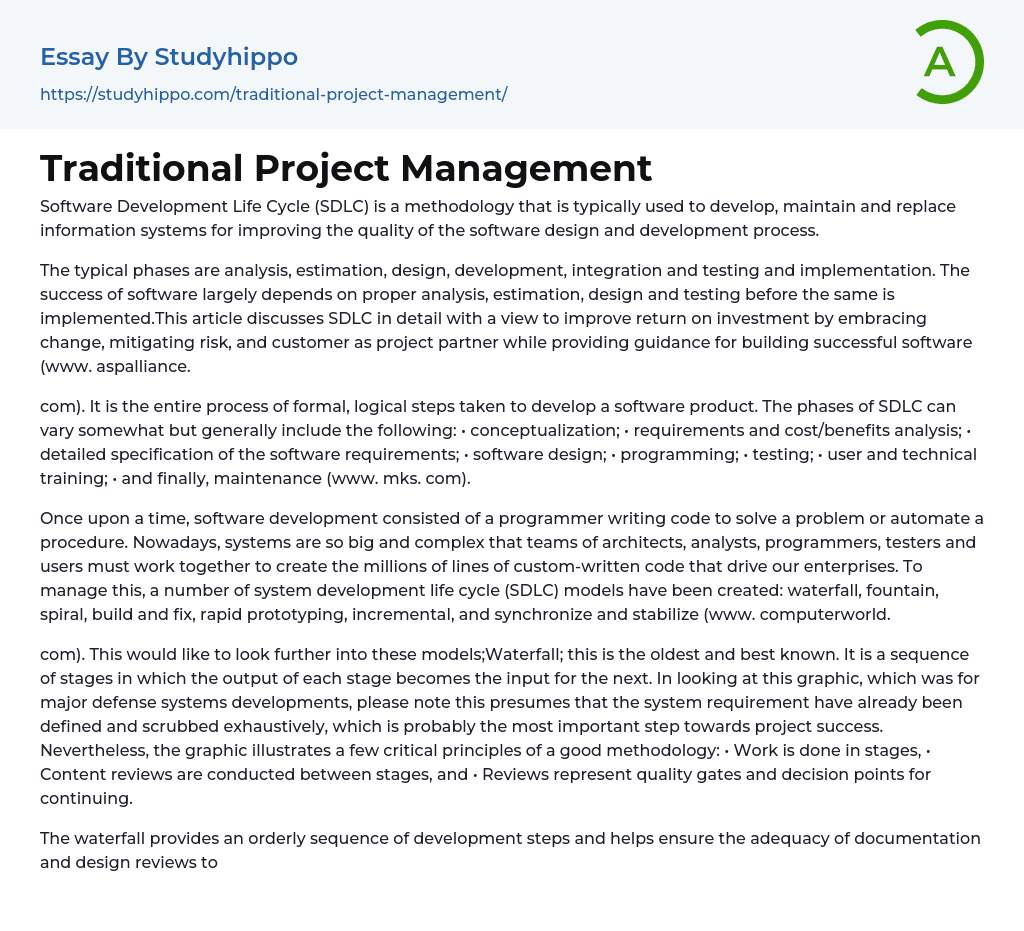The process of developing, maintaining and replacing information systems with the goal of enhancing the quality of the software design and development is commonly addressed through the Software Development Life Cycle (SDLC) methodology.
The standard phases involved in software development include analysis, estimation, design, development, integration, testing and implementation. The effectiveness of a software largely depends on performing thorough analysis, estimation, design and testing before implementation. This write-up thoroughly examines SDLC as a means of improving ROI by adopting a flexible approach to change, managing risk and partnering with customers as project collaborators, while offering guidance on creating successful software. (source: www.aspalliance.com)
According to www.mks.com, the whole procedure of developing a software product involves a series of formal and logical steps, collectively known as the Software Development Life Cycle (SDLC). The various phases of SDLC, though subject to ce
...rtain variations, mostly include conceptualization, analysis of requirements and cost/benefits, detailed specification of software requirements, software design, programming, testing, user and technical training and maintenance.
Nowadays, software development has evolved from a single programmer writing code to solve a problem or automate a procedure to a collaborative effort amongst architects, analysts, programmers, testers, and users in order to create millions of lines of custom-written code to drive enterprises. As a result, various system development life cycle (SDLC) models have been created to manage this complex process including waterfall, fountain, spiral, build and fix, rapid prototyping, incremental, and synchronize and stabilize (source: www.computerworld).
The article discusses various models in software development, particularly the Waterfall model. This model is the most well-known and oldest model available. It follows a sequence of stages where the output of each stage becomes the input
for the next. The accompanying graphic shows an example application of this model to major defense systems developments. However, it assumes that system requirements have already been defined and reviewed extensively, which is crucial for project success. The graphic demonstrates the key principles of an effective methodology, where work is done in stages, content reviews are conducted between stages, and reviews serve as quality gates and decision points for continuing.
Despite being criticized as slow and cumbersome, the waterfall methodology remains a valuable tool for software development. Its ordered sequence of development steps promotes thorough documentation and design reviews, ensuring software quality, reliability, and maintainability. Although simplistic and best suited for routine, mechanical-oriented software, the waterfall methodology embodies sound principles of life cycle development (source: www.hyperthot.com).
This is the point where automation of tasks performed by clerks and accountants is straightforward; However, when it comes to building advanced systems for knowledgeable workers, such as customer service personnel or corporate executives, it falls short. Another drawback is its assumption that users' sole function is to define requirements that can be entirely outlined beforehand. However, the reality is that requirements evolve and develop both during and after the process, necessitating significant feedback and iterative consultation (www).
Computerworld.com explains that the spiral methodology is the next step after the waterfall method. It revolves around incremental and iterative development, allowing for small beginnings and learning from experimentation. This evolution from the waterfall method focuses on multiple deliveries and handoffs, making it the ultimate progression from the previous approach.
The relationship of tasks with rapid prototyping, increased parallelism, and concurrency in design and build activities is reflected by the spiral methodology. It is
important to plan the spiral method systematically and identify tasks and deliverables for every step in the spiral.
- Genetic Engineering essays
- Bus essays
- Internal Combustion Engine essays
- Hybrid essays
- Electric Car essays
- Invention essays
- Mechanics essays
- Innovation essays
- Telephone essays
- Software Engineering essays
- Automobile essays
- Cycling essays
- Civil engineering essays
- Mechanical Engineering essays
- Bentley essays
- Cloud Computing essays
- Computer Science essays
- Consumer Electronics essays
- Data Analysis essays
- Electronics essays
- engineering essays
- Enterprise Technology essays
- Hardware essays
- Impact of Technology essays
- Information Age essays
- Information Technology essays
- Modern Technology essays
- Operating Systems essays
- people search essays
- Robot essays
- Board Of Directors essays
- Brand Management essays
- Business Ethics essays
- Business Management essays
- Change Management essays
- Comparative Analysis essays
- Decision Making essays
- Dispute Resolution essays
- Knowledge Management essays
- Leadership essays
- Leadership and Management essays
- Manager essays
- Operations Management essays
- Performance Management essays
- Product Management essays
- Project Management essays
- Quality Management essays
- Risk essays
- Risk Management essays
- Scientific Management essays




